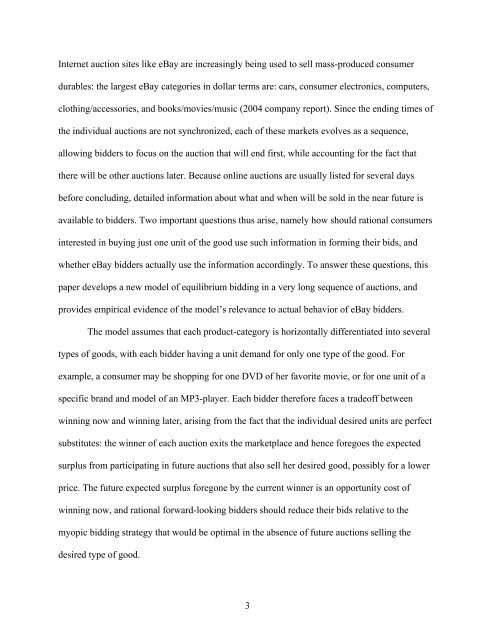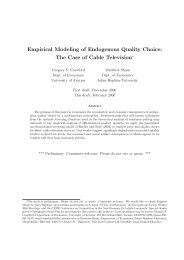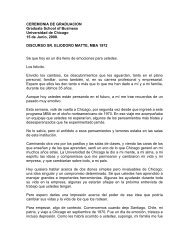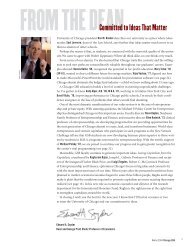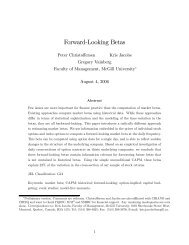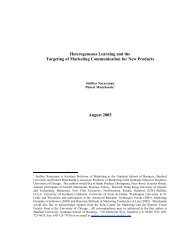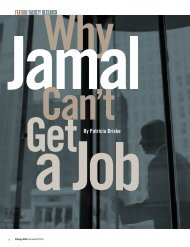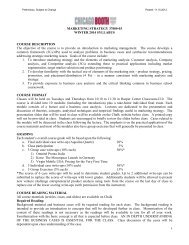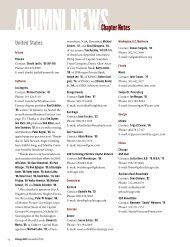Forward-Looking Bidding in Online Auctions. - The University of ...
Forward-Looking Bidding in Online Auctions. - The University of ...
Forward-Looking Bidding in Online Auctions. - The University of ...
- No tags were found...
Create successful ePaper yourself
Turn your PDF publications into a flip-book with our unique Google optimized e-Paper software.
Internet auction sites like eBay are <strong>in</strong>creas<strong>in</strong>gly be<strong>in</strong>g used to sell mass-produced consumerdurables: the largest eBay categories <strong>in</strong> dollar terms are: cars, consumer electronics, computers,cloth<strong>in</strong>g/accessories, and books/movies/music (2004 company report). S<strong>in</strong>ce the end<strong>in</strong>g times <strong>of</strong>the <strong>in</strong>dividual auctions are not synchronized, each <strong>of</strong> these markets evolves as a sequence,allow<strong>in</strong>g bidders to focus on the auction that will end first, while account<strong>in</strong>g for the fact thatthere will be other auctions later. Because onl<strong>in</strong>e auctions are usually listed for several daysbefore conclud<strong>in</strong>g, detailed <strong>in</strong>formation about what and when will be sold <strong>in</strong> the near future isavailable to bidders. Two important questions thus arise, namely how should rational consumers<strong>in</strong>terested <strong>in</strong> buy<strong>in</strong>g just one unit <strong>of</strong> the good use such <strong>in</strong>formation <strong>in</strong> form<strong>in</strong>g their bids, andwhether eBay bidders actually use the <strong>in</strong>formation accord<strong>in</strong>gly. To answer these questions, thispaper develops a new model <strong>of</strong> equilibrium bidd<strong>in</strong>g <strong>in</strong> a very long sequence <strong>of</strong> auctions, andprovides empirical evidence <strong>of</strong> the model’s relevance to actual behavior <strong>of</strong> eBay bidders.<strong>The</strong> model assumes that each product-category is horizontally differentiated <strong>in</strong>to severaltypes <strong>of</strong> goods, with each bidder hav<strong>in</strong>g a unit demand for only one type <strong>of</strong> the good. Forexample, a consumer may be shopp<strong>in</strong>g for one DVD <strong>of</strong> her favorite movie, or for one unit <strong>of</strong> aspecific brand and model <strong>of</strong> an MP3-player. Each bidder therefore faces a trade<strong>of</strong>f betweenw<strong>in</strong>n<strong>in</strong>g now and w<strong>in</strong>n<strong>in</strong>g later, aris<strong>in</strong>g from the fact that the <strong>in</strong>dividual desired units are perfectsubstitutes: the w<strong>in</strong>ner <strong>of</strong> each auction exits the marketplace and hence foregoes the expectedsurplus from participat<strong>in</strong>g <strong>in</strong> future auctions that also sell her desired good, possibly for a lowerprice. <strong>The</strong> future expected surplus foregone by the current w<strong>in</strong>ner is an opportunity cost <strong>of</strong>w<strong>in</strong>n<strong>in</strong>g now, and rational forward-look<strong>in</strong>g bidders should reduce their bids relative to themyopic bidd<strong>in</strong>g strategy that would be optimal <strong>in</strong> the absence <strong>of</strong> future auctions sell<strong>in</strong>g thedesired type <strong>of</strong> good.3


